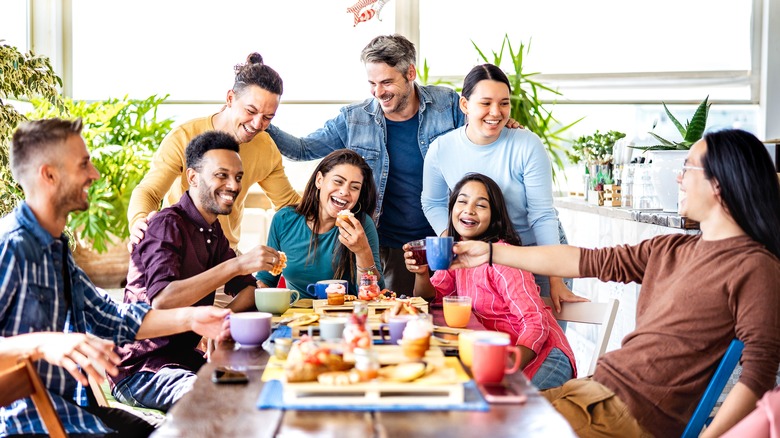The Coffee Brewing Blunder To Avoid When Hosting A Gathering
Making your morning coffee by way of the wonderful, humble French press not only yields a fantastic few cups, it can be a meditative process. Because of this, the time needed to make a small batch of artisanal brew might make you completely insane when trying to crank out after-dinner coffee for a large number of guests while worrying about clearing the table and serving dessert. The temptation might be to make a big batch of your hot postprandial beverage ahead of time — which, if you're using a drip machine, would literally leave a bitter taste in your mouth: Leaving a pot of coffee on heat (even low enough to just keep it warm) will not only result in a huge loss of freshness of flavor, but ultimately make it taste burned.
Even if you're entertaining enough guests to require more than one pot of coffee, the time it will take to brew two pots (and transfer them to a large metal carafe) won't be longer than twelve-to-fifteen minutes (at five minutes a batch). That's about the time it'll take to clear the dinner table and reset it for dessert or after-dinner drinks. The gorgeous flavor and aroma of a good cup of coffee entirely depends on things called volatile compounds, and anything volatile isn't around for very long. Wait until the last minute to grind the beans and brew your coffee, and watch your host status elevate accordingly.
Don't make a bitter mistake
There are several reasons why coffee might turn out bitter, but let's start with the flavor itself: Our palates are very sensitive to bitterness (which is distinct from sourness). The reason for this sensitivity probably has to do with the handy survival instinct of identifying toxicity, since most poisonous plants have a bitter taste. Of course, bitter can also be a wonderful part of a complex flavor profile (we're looking at you, Campari) — but in coffee, a pervasive bitterness is always distasteful.
So, what can make coffee bitter? The beans themselves might be over-roasted, which is a euphemism for burned — nothing to be done about that. Also, the grounds might get over-extracted because they're exposed to hot water for too long and too much caffeine and soluble flavors are extracted. However, if you're making coffee with an automatic drip machine, over-extraction is nearly impossible — but it can happen if you use more than the number of scoops needed for the perfect cup. That leaves temperature: Leaving a pot of coffee on heat will speed up the oxidation process that makes it taste bitter and stale. Heck, even letting it sit around will do that — as well as make the coffee go cold; a depressing option.
Volatile thiols and why you should care
The organic compounds most responsible for the delicious roasted coffee aroma and flavor are called thiols. They come to be during roasting, and they're volatile little guys, prone to loss through oxidation after the brewing process. (One of these is a sulfur compound called methanethiol, which is most present in espresso.) Once these thiols degrade, coffee will go stale — and higher temperatures only accelerate this process. This is a long way of saying that leaving your pot of pre-made party coffee sitting on heat is self-defeating.
The solution is to transfer your freshly-brewed coffee to a thermal metal carafe and bring that to the table. These carafes are insulated by a double wall separated by a vacuum, so they're not only great at keeping the coffee at its ideal serving temperature, they also minimize heat transfer and loss — meaning a vastly lower rate of oxidation and thiol degradation. With that settled, it's on to these other ways to upgrade your coffee.


